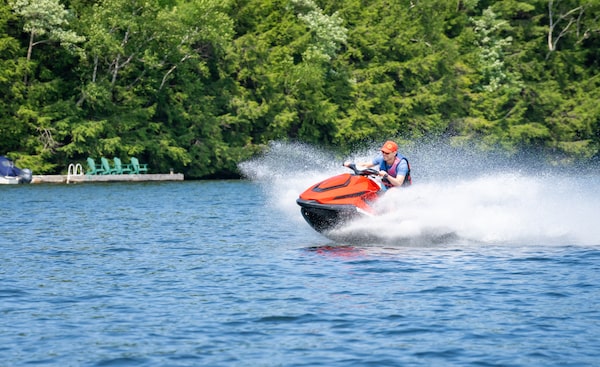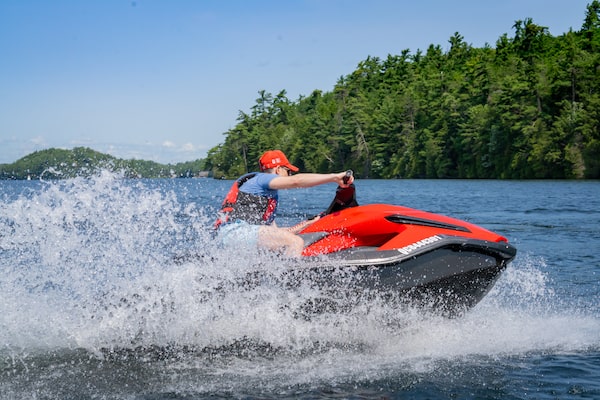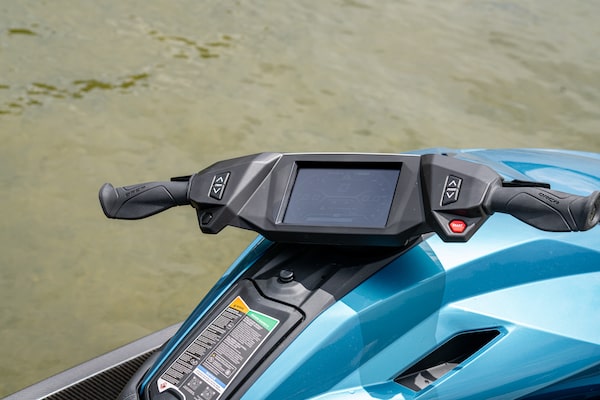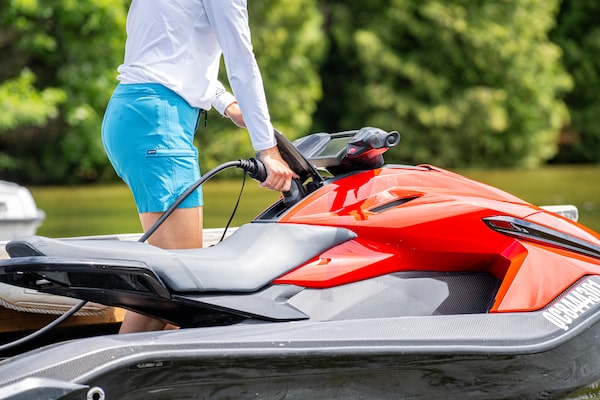
Jordan Chittley rides the electric Taiga Orca Carbon on Lake Joseph in Ontario.Phil Henderson/Courtesy of manufacturer
I’m about to make waves, quietly, in cottage country.
The only way to know that my Taiga personal watercraft is on is by looking at the digital display screen. Most prominently, three blue numbers appear – with the middle and largest one showing my speed.
As I ready myself for my test ride, I’m sitting calmly in the water, listening to the wind in the trees. Then, with a slight squeeze of the throttle, I’m jolted back as the $34,000 limited-edition Orca Carbon accelerates at a pace considered fast even for an electric car. (Taiga Motors Corp. says the Orca can shoot to 100 kilometres an hour in 4.5 seconds). With no back rest to hold me in place, I found myself gripping the handlebars for dear life, trying my best not to go for a swim.
Within a few seconds, I was skipping across the small waves of Lake Joseph at 94 kilometres an hour. Taiga says the Orca’s top speed is 104, but I’m not sure I have the skill or bravery (or foolhardiness, perhaps) to hit that. And it does all this without using a drop of gas.
“It has all the fun elements people would be looking for,” says Taiga co-founder and chief executive officer Samuel Bruneau, explaining that its performance is similar to the best gas-powered personal watercraft (PWC). But, he says, Taiga removes the two big drawbacks when it comes to PWCs – the noise and the environmental impact of burning fuel. (Though the electric versions don’t burn gas or emit carbon, all personal watercraft create a wake when they speed across the water, which critics and boating organizations say can disturb shore-nesting birds and aquatic species, and cause stress to wildlife. When ridden close to shore, they can also damage aquatic plants and stir up sediment, making it harder for fish and birds to feed.)

Jordan Chittley rides the electric Taiga Orca Carbon on Lake Joseph in Ontario.Phil Henderson/Courtesy of manufacturer
“We can’t offer vehicles with very heavy environmental impacts in these really pristine environments and lakes and mountains and trails – places where you want it to be quiet. You want the air to be pure,” he says. “We saw the opportunity to push the segment toward electrification because the industry was content to stay with the gas model for as long as possible.”
The Taiga Orca Carbon is the world’s first production electric personal watercraft. While the ride is thrilling, the Montreal-based company, which also makes electric snowmobiles, has struggled with production issues, sales and a slumping stock price.
Taiga, which began in 2016, delivered its first snowmobiles in the spring of 2022 and its first watercraft that summer. In 2021, it went public on the Toronto Stock Exchange with an implied market capitalization of $537-million and a stock price of $13.25. Since that first day, its stock has dropped by 87 per cent to $1.77 a share, with a market value of $56-million.
Taiga has more than 3,300 orders (which require a deposit of about $100 depending on the model), but so far has produced and delivered about 350 machines as of the middle of May. In the first quarter of 2023, it sold 59 vehicles (39 watercraft and 25 snowmobiles) and The Globe and Mail reported in March that Taiga is burning through cash at a rate of about $15-million to $20-million a quarter. Bruneau says that is because of heavy investment needed on its manufacturing lines, but that the burn rate will eventually come down.
Taiga recently secured $46-million in convertible debt. “That really gives us the runway to deliver on this production ramp-up,” Bruneau says.
He says the company’s supply chain issues have been resolved, production is ramping up and it expects to turn those numbers around. The company hopes to deliver 1,700 to 1,900 vehicles in 2023, all from its Montreal facility that has a capacity of 8,000 units a year.
“As a newcomer in the industry, we were one of the first to suffer and perhaps suffer the most from [supply-chain issues in 2021],” Taiga marketing director Annick Lauzon says as we sit on the dock at Gordon Bay Marine in MacTier, Ont., just south of Parry Sound. “I think right now [investors] are watching and waiting to see what is going to happen through 2023 and making sure we can meet that ramp-up objective.”
Unlike for cars, there are no government mandates or consumer incentives for personal watercraft or snowmobiles to switch to electric, but Taiga is hoping to become the Tesla of the powersports market.
“As the technology continues to evolve and the price points continue to fall, that switch over is going to happen very fast, regardless of incentives,” Bruneau says. He says people often buy these machines for the fun factor and when it comes to fun, you can really feel the power of electrification.

The seven-inch display screen on the Taiga Orca Carbon. On the screen, numbers illuminate to show the craft is ready to go. Buttons on the left control the trim and buttons on the right control the mode.Phil Henderson/Courtesy of manufacturer
Similar high-performance gas-powered PWCs cost at least $10,000 less, but Taiga has an advantage of being able to attract a new audience.
“A lot of our customers that are buying the PWCs, they’re not replacing a gas one,” Bruneau says. “They don’t want to be the one on the lake bothering their neighbours with the noise.”
Lauzon adds that a lot of Taiga’s customers have already switched to driving an electric car or truck.
While the $34,000 price point will likely attract only a small number of buyers, Taiga is building fewer than 400 high-end Carbon models. Bruneau compares it to when Tesla released the Roadster. They had to show what was possible with a premium model.
“The [longer-term] mission is to deliver a watercraft at a price point similar to gas vehicles and that is what the next two mass-market products aim to do,” he says.
In August, Taiga plans to introduce a $24,000 version that will have the same battery and powertrain, but be made with a plastic composite common in the PWC industry instead of carbon fibre. Next year, they plan to offer an even less expensive model for about $20,000.
“For us, it was [about] providing the best electric option possible, so we didn’t want there to be a compromise for someone between performance and electric,” says Lauzon. “Yes, it costs a little bit more, but it is a very premium model. We have a design ethos that is inspired by the automotive industry.”
Bombardier Recreational Products Inc., the dominant maker of personal watercraft in a market that also includes Kawasaki, Yamaha and Honda, has shown a concept electric SeaDoo and is hinting it will enter the market, but Lauzon says Taiga has a first-mover advantage with seven years of research and development devoted to electric.
“We don’t have a legacy combustion engine lineup to worry about, so all of our efforts are going into making the best electric technology and the best battery,” she says. “Our task is maintaining that advantage and continuing to improve our products.”
The Orca Carbon has a 25-kilowatt-hour lithium-ion battery, 160 horsepower and a range of up to 45 kilometres or about two hours. But if you are constantly gunning it, that range decreases significantly. I watched the battery charge drop by about 30 per cent in 20 minutes during my test drive.

The Taiga Orca Carbon takes about 3.5 hours to charge on a Level 2 charger or about 14 hours at a Level 1.Phil Henderson/Courtesy of manufacturer
Its battery can be replenished in about 3.5 hours at a Level 2 charger or about 14 hours at a Level 1. The on-board charging capability is 6.6 kilowatts and Taiga says Level 3 fast-charging capability is coming.
All of this means it can be charged at any EV charging station and most marinas, because they already have 240-volt outlets to provide shore power for boats.
“The advantages of electric are much greater off-road than on-road,” says Bruneau. “Modern cars are very quiet, their emissions profiles are quite low; you [can’t] tell much of a difference when driving an electric car than a modern gas car. Whereas off-road, they are still very loud.” Further, he says, two-stroke engines emit up to 150 times as much carbon per kilometre as gas-powered cars do. And “they smell bad.”
After I scare myself with some straight-line accelerations, Lauzon suggests I try some doughnuts. She wants me to see how stable and also playful it is. Because the heaviest part of the watercraft, the battery, sits at the bottom, around the waterline, it is nearly impossible to tip it over.
That’s not to say that riding one is entirely without risk, especially when you’re gunning it at top speed. You have to keep your eyes peeled and be alert because swimmers, other boaters and wildlife come up fast at that speed.
About 45 minutes after my ride ends, I hop into my family station wagon, turn onto the highway and hit the gas. It feels like I’m barely accelerating.